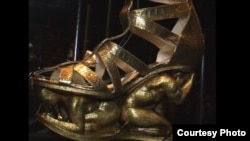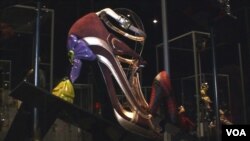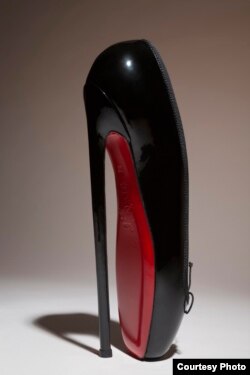NEW YORK —
"Shoes occupy a very special place in the female imagination," says Valerie Steele, director and chief curator of the Museum at the Fashion Institute of Technology (FIT) in New York.
The museum’s current show, "Shoe Obsession," presents some of the most extreme examples of those objects of desire: fantastically wrought sky-high heels by leading designers, with prices equally unreachable.
Beautifully-made, imaginatively-designed high heels can confer upon the wearer an Olympian sense of power, beauty, and status, Steele says.
"Handbags have some of that aspect, but shoes are so much more playful than that," she says. "Many women I have talked to say the shoes talk to them. They say, 'buy me, take me home.’ And unlike clothing, shoes have a shape, they are sculptural, and some women said they almost didn’t care whether they would be wearing the shoes much. They said, ‘I can put it on my coffee table and just admire it.’ I think for a lot of women, there’s something about shoes, they’re like little miniature works of art."
With examples both from established design houses like Prada and Chanel, and rising young designers from Europe, the U.S. and Japan, the FIT museum show is about the increased popularity of luxury designer shoes, highlighted by the television show, "Sex and the City."
"Over the past 10 years, more and more women have become interested in high-end designer shoes, so something that a decade ago was only the province of a real sort of shoe addicts, as in ‘Sex and the City,’ now has become democratized," Steele says.
"And everyone knows Manolo Blahnik and Christian Louboutin and a host of other designers. So, in this show, we look at the 21st century phenomenon of shoe obsession, and explore how it is that shoes have moved from being accessories to being the main fashion story."
Steele says that although women of all classes are wearing very high heels, many keep them in reserve most of the time.
"Most women are not running down the street in five-inch heels," she says. "They might have a pair in their office that they switch into before a meeting when they want to have an extra shot of confidence."
Even in Saudi Arabia and other Middle Eastern countries, she says, where women's dress is required to be modest, the interest in shoes is no less.
"It's just that you don't see it in public. The context of showing off your fashion is in private, in all-women gatherings," Steele says.
History of the Heel
Heeled shoes may have been invented by ancient horsemen in the Near East, says Elizabeth Semmelhack, curator at the Bata Shoe Museum in Toronto, Canada. A heel helped riders keep their feet in the stirrups. The style was adopted in the 1590s by European men, and then by women.
"There’s the famous portrait of Louis the 14th, the king of France, wearing high-heeled shoes with red heels," says Steele. "However, it seems that even from the beginning men’s heels were somewhat thicker than women’s. Women’s were more curved and delicate-looking. And as time went on, women’s heels became taller than men’s heels. And then by the later part of the 18th century, men pretty much stopped wearing high heels, and it became exclusively a feminine fashion."
In the late 18th century, according to the book, "Survival of the Prettiest: The Science of Beauty," by Nancy Etcoff, England’s parliament passed a law requiring the same punishment for female adornment as for witchcraft. Among the forbidden provocations were paints, scents, artificial teeth, false hair, bolstered hips -- and high-heeled shoes.
"The law was unenforceable," Etcoff writes. But for the next few centuries, heels had to remain somewhat chunky. It took new technologies in plastic and steel production in the early 1950s to make possible the stiletto heel, a long, extremely slender spike.
On Display
The most fanciful of the shoes in the FIT museum show look like theater props.
One display consists of golden tie-up sandals supported by figurines of laboring, crouching men. They were designed by Rupert Sanderson for a production of Verdi’s Aida, whose protagonist is a slave in ancient Egypt. Japanese designer Masaya Kushino’s "Wind Horse" shoes have a wooden ball-like platform and a trailing golden ponytail. Shoes designed by Janina Alleyne evoke insect exoskeletons, while Tea Petrovic’s prototypes resemble space-age architecture.
Another design, by Maison Martin Margiela, is literally unwearable. In a reference to the Cinderella story, they are high-heeled slippers made of glass.
Some of the shoes look like weapons. A sharp horn like a rhinoceros’s protrudes from the top of a hoof-like Noritaka Tatehana design. A Chanel high heel is made in the form of a downward-pointing pistol.
The sheer difficulty and sometimes painfulness of these designs is part of the challenge: only physically superior beings exercising a powerful will can manage to stand and walk in these shoes. And only the wealthiest can afford to spend thousands on collections of shoes that are impractical for more than brief display.
Ultra-high shoes that lack any heels at all are a recent innovation that have been taken up enthusiastically by those few. The wearer balances on the ball of her foot, always pitching forward slightly, like a long-legged bird.
Valerie Steele said she exercised her legs and feet for weeks before wearing a pair to the FIT museum show’s opening reception.
She lasted half an hour in them.
The museum’s current show, "Shoe Obsession," presents some of the most extreme examples of those objects of desire: fantastically wrought sky-high heels by leading designers, with prices equally unreachable.
Beautifully-made, imaginatively-designed high heels can confer upon the wearer an Olympian sense of power, beauty, and status, Steele says.
"Handbags have some of that aspect, but shoes are so much more playful than that," she says. "Many women I have talked to say the shoes talk to them. They say, 'buy me, take me home.’ And unlike clothing, shoes have a shape, they are sculptural, and some women said they almost didn’t care whether they would be wearing the shoes much. They said, ‘I can put it on my coffee table and just admire it.’ I think for a lot of women, there’s something about shoes, they’re like little miniature works of art."
With examples both from established design houses like Prada and Chanel, and rising young designers from Europe, the U.S. and Japan, the FIT museum show is about the increased popularity of luxury designer shoes, highlighted by the television show, "Sex and the City."
"Over the past 10 years, more and more women have become interested in high-end designer shoes, so something that a decade ago was only the province of a real sort of shoe addicts, as in ‘Sex and the City,’ now has become democratized," Steele says.
"And everyone knows Manolo Blahnik and Christian Louboutin and a host of other designers. So, in this show, we look at the 21st century phenomenon of shoe obsession, and explore how it is that shoes have moved from being accessories to being the main fashion story."
Steele says that although women of all classes are wearing very high heels, many keep them in reserve most of the time.
"Most women are not running down the street in five-inch heels," she says. "They might have a pair in their office that they switch into before a meeting when they want to have an extra shot of confidence."
Even in Saudi Arabia and other Middle Eastern countries, she says, where women's dress is required to be modest, the interest in shoes is no less.
"It's just that you don't see it in public. The context of showing off your fashion is in private, in all-women gatherings," Steele says.
History of the Heel
Heeled shoes may have been invented by ancient horsemen in the Near East, says Elizabeth Semmelhack, curator at the Bata Shoe Museum in Toronto, Canada. A heel helped riders keep their feet in the stirrups. The style was adopted in the 1590s by European men, and then by women.
"There’s the famous portrait of Louis the 14th, the king of France, wearing high-heeled shoes with red heels," says Steele. "However, it seems that even from the beginning men’s heels were somewhat thicker than women’s. Women’s were more curved and delicate-looking. And as time went on, women’s heels became taller than men’s heels. And then by the later part of the 18th century, men pretty much stopped wearing high heels, and it became exclusively a feminine fashion."
In the late 18th century, according to the book, "Survival of the Prettiest: The Science of Beauty," by Nancy Etcoff, England’s parliament passed a law requiring the same punishment for female adornment as for witchcraft. Among the forbidden provocations were paints, scents, artificial teeth, false hair, bolstered hips -- and high-heeled shoes.
"The law was unenforceable," Etcoff writes. But for the next few centuries, heels had to remain somewhat chunky. It took new technologies in plastic and steel production in the early 1950s to make possible the stiletto heel, a long, extremely slender spike.
On Display
The most fanciful of the shoes in the FIT museum show look like theater props.
One display consists of golden tie-up sandals supported by figurines of laboring, crouching men. They were designed by Rupert Sanderson for a production of Verdi’s Aida, whose protagonist is a slave in ancient Egypt. Japanese designer Masaya Kushino’s "Wind Horse" shoes have a wooden ball-like platform and a trailing golden ponytail. Shoes designed by Janina Alleyne evoke insect exoskeletons, while Tea Petrovic’s prototypes resemble space-age architecture.
Another design, by Maison Martin Margiela, is literally unwearable. In a reference to the Cinderella story, they are high-heeled slippers made of glass.
Some of the shoes look like weapons. A sharp horn like a rhinoceros’s protrudes from the top of a hoof-like Noritaka Tatehana design. A Chanel high heel is made in the form of a downward-pointing pistol.
The sheer difficulty and sometimes painfulness of these designs is part of the challenge: only physically superior beings exercising a powerful will can manage to stand and walk in these shoes. And only the wealthiest can afford to spend thousands on collections of shoes that are impractical for more than brief display.
Ultra-high shoes that lack any heels at all are a recent innovation that have been taken up enthusiastically by those few. The wearer balances on the ball of her foot, always pitching forward slightly, like a long-legged bird.
Valerie Steele said she exercised her legs and feet for weeks before wearing a pair to the FIT museum show’s opening reception.
She lasted half an hour in them.









